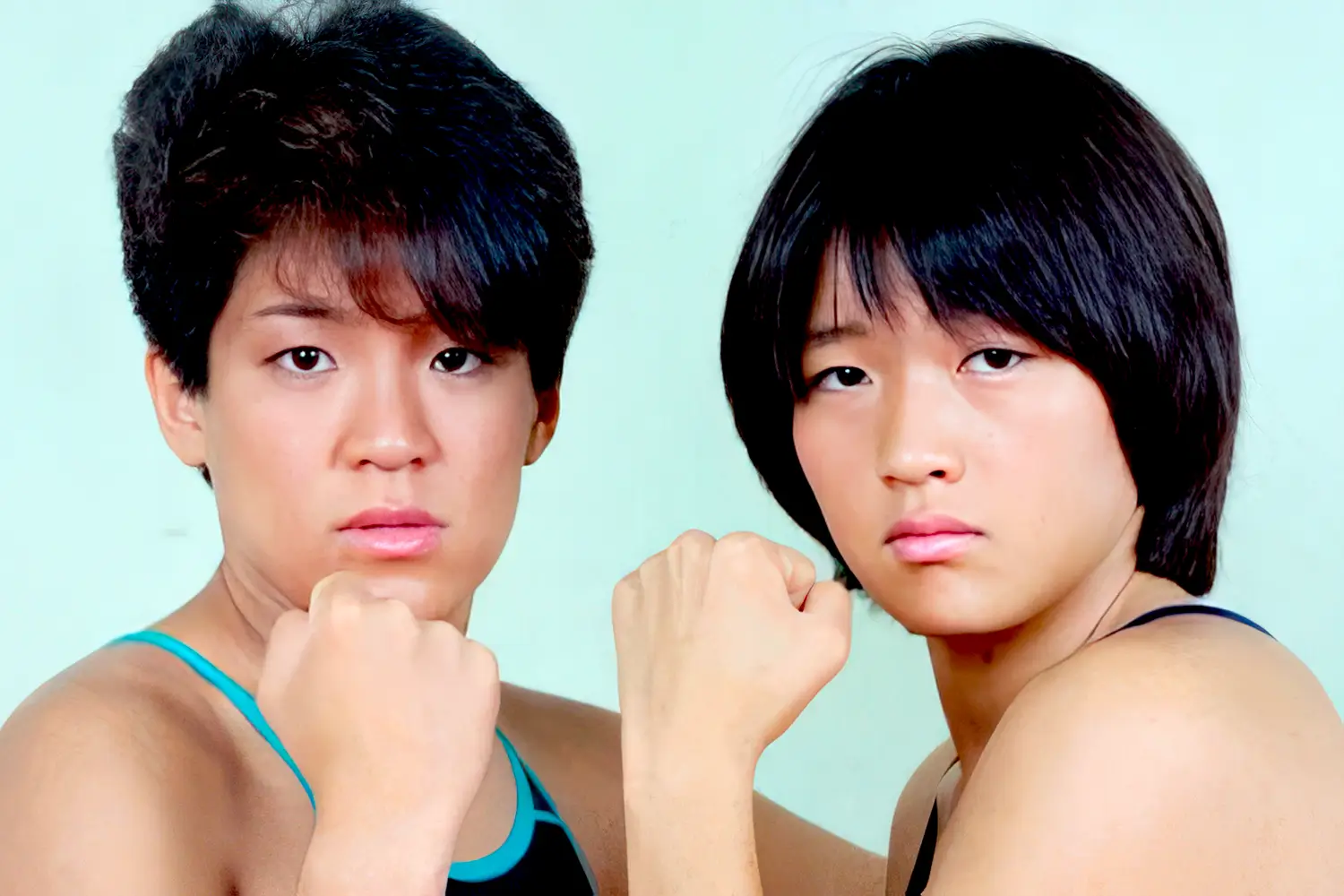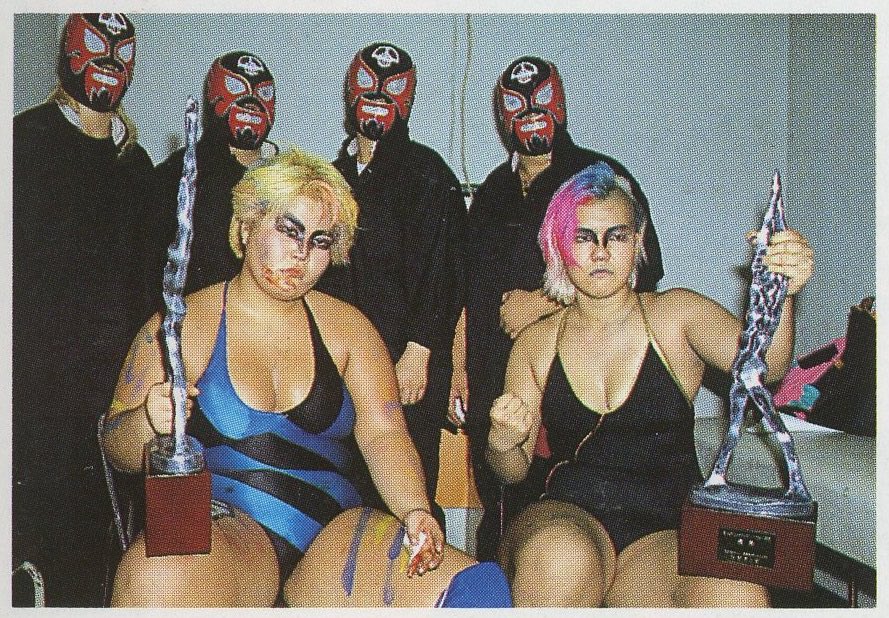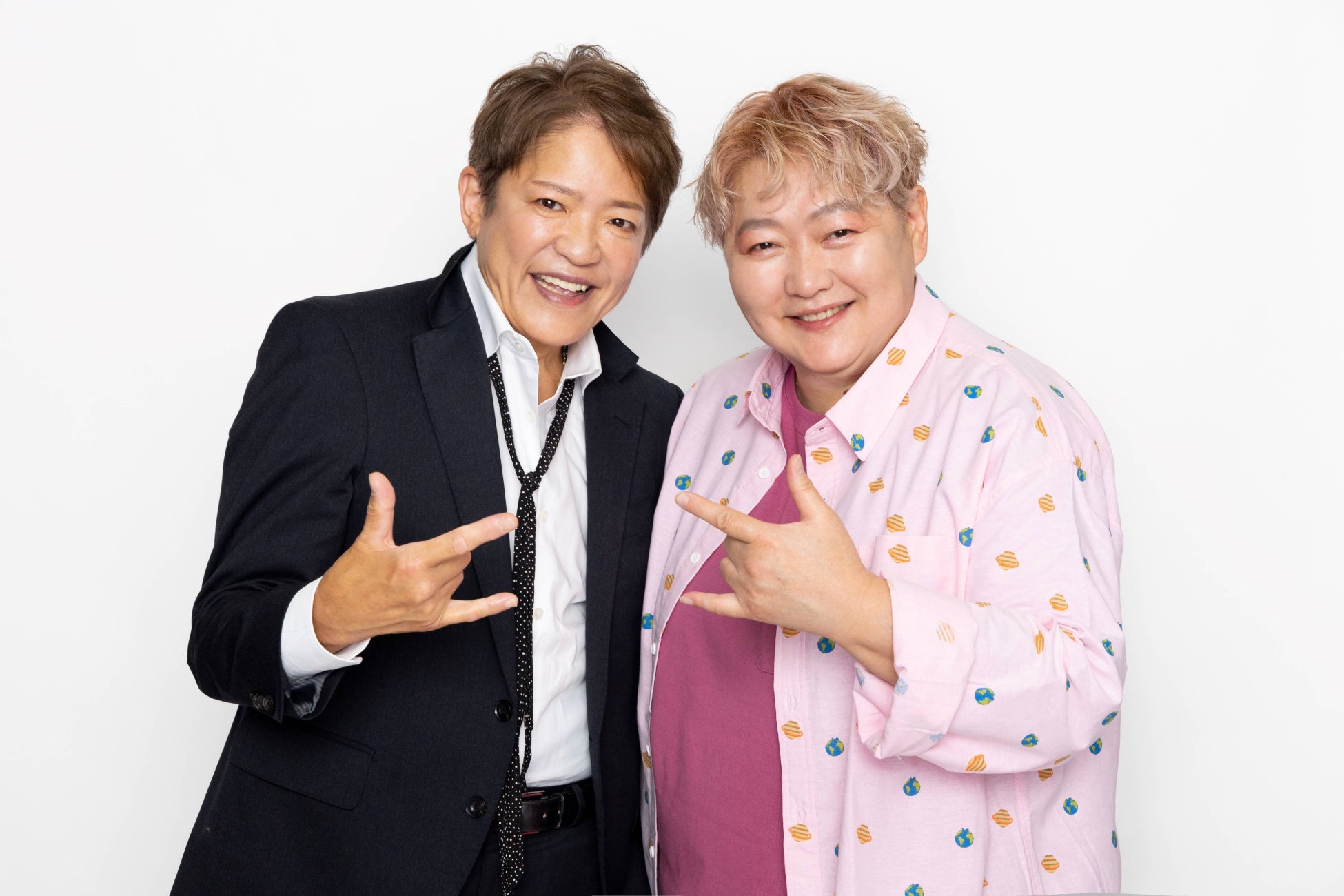The Crush Gals were one of the most popular Joshi Puroresu tag teams in wrestling history during the eighties. Lioness Asuka & Chigusa Nagayo sold out arenas across Japan as a team and as foes.
The two transcended the meaning of the word popular and became icons in their home country of Japan, turning wrestling fans from Hokkaido to Okinawa into Crush Gals fans.
Lioness Asuka & Chigusa Nagayo were sensational competitors in their own right but their stories are forever intertwined with one another, making it impossible to tell the story of one without telling the story of the other.

Before the Crush Gals
Both Lioness Asuka and Chigusa Nagayo started out as teenagers in All Japan Women’s Pro-Wrestling (AJW), undeniably the biggest joshi puroresu promotion of the time, in 1980. Neither had reached the age of eighteen by the time they debuted, but the two quickly became hits with fans of all genders and demographics.
Lioness Asuka competed under her birth name, Tomoko Kitamura, for the first two years of her career, which saw her debut in a feud with Wendi Richter and defeat Noriko Kawakami to win the vacant AJW Junior Championship in 1981.
From then on, Kitamura would be known as Lioness Asuka, which was just in time for her AJW Championship win the following year after she defeated Masked Yu for the vacant title.
Chigusa Nagayo made her debut late in the year against Mexican luchadora Irma Gonzalez and was crowned Rookie of the Year for 1981 after defeating Noriyo Tateno in the tournament finals.
Nagayo would also win the AJW Junior Championship after Lioness Asuka by defeating Itsuki Yamazaki for the vacant title.
Both showed promise as singles competitors, and it was their standout 1982 performance against one another in a time-limit draw where it became obvious that the two had a chemistry in the ring like no other pairing.

Short Hair & Swimsuits
The first instance of the two teaming together came when they were defeated in a handicap match by the then-WWF star Princess Victoria. The loss to the foreign star would be a blip, however, as the two went on to earn a WWWA Tag Team Championship opportunity against the Dynamite Girls, Jumbo Hori & Yukari Omori.
They would debut the name for their tag team in the match – the Crush Gals. The name is a combination of shoot-style wrestler Akira Maeda’s nickname and a popular Japanese magazine called Gals.
The debut of a name that would become synonymous with the eighties wrestling in Japan would not be enough to see the team claim the tag titles as they lost the match, conceding two out of three falls to the Dynamite Girls.
Win or lose, the match blew their popularity sky-high. In such little time, the pair had become standout babyfaces in a roster of villains, and they became the team that everyone bought tickets to see.
The Crush Gals took on all comers in their attempt to get their hands on the WWWA Tag Team titles that they had failed to capture. This run saw them pick up a number of victories against various teams and individuals, as well as go from bell to bell in a sixty-minute match with Jaguar Yokota & Devil Masami.
Nagayo picked up another AJW Junior Championship win, while Lioness Asuka picked up another AJW Championship win, but the best had yet to come for the duo.
At this point, the Crush Gals’ popularity rivaled the biggest stars in Japan; it was comparable to that of Hulk Hogan in the States and Big Daddy in the UK. The way fans responded to them was similar to how a fan of a music star or a Japanese Idol may respond to their favorite artist.
There was no better way to cement this as fact than for the Crush Gals to release a hit single. In 1984, their first music single, “Bible of Fire,” sold over 100,000 copies in Japan even though Nagayo had never sang in public before its release. They also released two chart-topping albums, Square Jungle and Crush Gals Forever.

The Atrocious Alliance
It’s hard to believe that the most over-tag team in the world at the time hadn’t claimed the WWWA Tag Team titles yet. The time was finally upon them, though. Their long-awaited rematch with the Dynamite Girls took place in 1984, and the Crush Gals finally captured the titles at Korakuen Hall.
In the eyes of every fan, the Crush Gals were at the top of AJW. They may even have been at the top of Japan. But an obstacle still remained for the duo, and it came in the form of Bull Nakano, Dump Matsumoto, and their faction – The Atrocious Alliance.
As the name suggests, this alliance of Joshi wrestlers were the top heels in AJW, and with a pair of babyfaces now at the top of the tag team division, they sought to put an end to the Crush Gals’ reign and status in AJW.
This feud was the culmination of a story that quietly brewed ever since their debuts back in 1980. Dump Matsumoto and Bull Nakano were present at the beginning for the Crush Gals and they would be there at what they hoped to be the Crush Gals’ demise.
Matches that involved the Crush Gals against members of the Atrocious Alliance drew ratings incomparable to any other competitors in any promotion, including in North America.
The matches that aired on Fuji TV drew ratings of over 12.0 regularly, meaning that 12% of households in Japan watched the Crush Gals on a regular basis. The level of fame the two had achieved during this period came with some unwanted attention as Nagayo had to move house a number of times because of the large number of fans that would gather outside her house to see her.
As the two groups went back and forth, the Crush Gals lost their Tag Team titles to Crane Yu & Dump Matsumoto after a brief detour for a title defense in Mexico. They were also defeated by Bull Nakano and Dump Matsumoto in the AJW Tag League final in 1985.
As if things couldn’t get much worse, Chigusa Nagayo was forced to shave her hair off after losing a hair vs. hair match to Dump Matsumoto, who herself sported an extravagant mohawk.
The two were due a short break from the Atrocious Alliance, which came in the form of a trip to the US to compete in two WWF matches. They were successful in both matches before returning to AJW to get revenge on the Atrocious Alliance.
Following Crane Yu’s retirement, the WWWA Tag Team titles were vacated. This gave the Crush Gals an opportunity to beat Dump Matsumoto and her second partner, Bull Nakano, for the vacant belts, which they did.
Their second reign would last over two hundred days before Chigusa Nagayo’s injury forced the two to vacate the titles. Upon Nagayo’s return, the Crush Gals won the titles for a third time and drop it back to the Atrocious Alliance after an injury to Lioness Asuka.
The End of the Crush Gals?
The Crush Gals briefly separated in to pursue singles feuds. Lioness Asuka successfully defeated Bull Nakano, while Chigusa Nagayo sought revenge on Dump Matsumoto for shaving her hair and destroying her clothes.
She did manage to shave Matsumoto’s hair off after their rematch and captured the All-Pacific Championship around the same time. Chigusa Nagayo had a number of successful outings for Stampede in Canada during this period.
Their respective victories brought about a unique situation. As individuals, they had defeated the top two heels in the promotion and could both stake a claim to be the number one contender for the WWWA World Championship.
A match between the two was set for February 1987 in Kanagawa. The match lasted thirty-five minutes and went down as one of the greatest matches in AJW history. Lioness Asuka came out on top and went on to challenge reigning WWWA World Champion Yukari Omari.
Lioness Asuka was unsuccessful in her attempt to dethrone Omari but Chigusa Nagayo was not. Nagayo unified her All-Pacific Championship with Omari’s WWWA World Championship at AJW War Dream.
The Crush Gals would then briefly reunite for a number of tag matches involving Dump Matsumoto before Nagayo and Lioness Asuka would compete against each other in 1988 for the Unified Championship.
Lioness Asuka won the belt via forfeit after Chigusa Nagayo’s injury, yet out of respect for Nagayo, Lioness Asuka refused the belt and waited for Nagayo to recover before the two would have their fourth match against each other in 1989.
Lioness Asuka would defeat Nagayo for the Unified Championship with no sign of any injuries to either competitor.
Due to the nature of Joshi wrestling in AJW, it was expected that all competitors would retire by the time that they reached 26. At the age of 26, they were expected to settle down, start families, and live a life outside of the ring.
Even so, there was still time for one last run together as WWWA Tag Team Champions. They picked up the belts from the Calgary Typhoons (Mika Komatsu & Yumi Ogura) and carried them up until Nagayo retired in May. Lioness Asuka would follow Nagayo into retirement with her WWWA World Championship in July.
Life After the Crush Gals
Lioness Asuka was one of a number of AJW stars who realized that retiring in their twenties wasn’t as beneficial as the promotion believed it to be.
In November 1994, Lioness Asuka laced up her boots once more for AJW, forming a new faction called Raijin Corps with Jaguar Yokota and Bison Kimura in the process. She was not booked as the mega star she was before her retirement and competed primarily in trios matches with her faction.
Lioness Asuka appeared for WWF Survivor Series in 1995 with a team of all-Joshi wrestlers to face and defeat another team that featured Alundra Blayze. This would earn her a dark match against Blayze two nights later with the WWF Women’s Title on the line, though Lioness Asuka was not successful on that occasion.
Yoshimoto Women’s Pro Wrestling Jd’s events played host to Lioness Asuka for a number of years. There, she won the TWF World Women’s Championship on multiple occasions. Later, she competed for Major Girl’s Fighting AtoZ and briefly CMLL prior to and during her final endeavor with Chigusa Nagayo.
Chigusa Nagayo would return to AJW in 1993, losing to Devil Masami and Bull Nakano. She quickly moved on to a brand new promotion the year after – the Japanese Women Pro-Wrestling Project (JWP). She would have lengthy matches for the promotion throughout the year and into the next.

GAEA Girls
1995 saw the birth of another brand new Joshi wrestling promotion – GAEA Japan. GAEA took its name from the Greek mythological goddess of the Earth and was founded by Chigusa Nagayo and her business partner Yuka Sugiyama.
The aim of GAEA Japan was to train and bring through the next generation of Joshi wrestlers. Nagayo would oversee the training herself and evaluate whether the hopefuls were ready to make their debut for the promotion.
GAEA Japan’s training school was the subject of the BBC documentary GAEA Girls, which explored the ins and outs of Chigusa Nagayo’s training, her students, and the lives they lived in their pursuit of becoming pro wrestlers.
The documentary is a must-watch for those interested in Joshi wrestling and is worth showing to people with little to no interest in pro wrestling.
Nagayo received criticism for her brutal training methods. She would put the trainees through military-like drills and wear many down to the point of exhaustion in an effort to analyze their will to become a professional wrestler that their opponent could be proud to stand across from in the ring.
Her trainees suffered injuries; a number of them departed from the process before their final test, and one even ran away.
Saika Takeuchi was by no means the star of GAEA Japan, but she was a standout example of what a trainee under Nagayo would experience. Takeuchi was one of Nagayo’s students who trained under her and fellow student Meiko Satomura, who took on a senior role among the other students.
Takeuchi was left bloodied by a horrific dropkick from Satomura while training for her first exam. She failed her first exam and begged Nagayo for another chance. Eventually, Nagayo gave Takeuchi her second exam, and she passed, allowing her to debut at Korakuen Hall in 1999.
Saika Takeuchi’s career was short. She may not be remembered as a star of joshi wrestling but anyone who knows about GAEA will remember her inspirational spirit in the face of adversity.
As part of the GAEA Girls documentary, Nagayo gave some insight into why she employs such a harsh level of training:
“My father’s way of teaching has been passed on to me,” she said. “Every time I slapped her (Takeuchi), my hand hurt… more than that, my heart ached. Every time I wonder if I’ve done the right thing or not.”
It was evident that Nagayo was looking for a specific response from her students. She expected them to think, in her words, something along the lines of “You b***h Nagayo, I’ll beat you one day.”
GAEA Japan wasn’t just known for its developmental talent. They acquired a number of Joshi stars to fill the main event spotlight with Nagayo, including Toshiyo Yamada, Akira Hokuto, and, of course, Lioness Asuka.
Lioness Asuka would play the heel to Chigusa Nagayo’s face when she arrived in GAEA, Japan. Nagayo lost to Lioness Asuka in Asuka’s debut match for the promotion and, as part of the story, gave up her role as president of GAEA to Asuka.
Their rematch would raise the stakes even further: if Nagayo lost, she would have to go by the name Zero for the rest of her career. Luckily for Nagayo, her trainees were in her corner and lent her the match required to throw fire in Lioness Asuka’s face to get the win.
In 2000, Nagayo and Lioness Asuka would put aside their differences and reunite for GAEA as the Crush Gals, or Crush 2000 as they were known as in this incarnation, for the first time in over ten years.
Lioness Asuka retired with GAEA Japan in 2005, citing multiple neck injuries as the reason for hanging up her boots. Her final match came at the side of her tag partner Nagayo with a victory over Chikayo Nagashima & Sugar Sato at GAEA’s tenth-anniversary show.
She would, however, make a special appearance in 2013 during Diana Pro-Wrestling’s Queen Champion Title Tournament, where she lost to Kyoko Inoue.
Though GAEA Japan was still a profitable promotion, it closed its doors in 2005 at an event titled “Eternal Last Gong.” Many of the original members of the promotion had moved on, and Nagayo herself had a desire to retire.
At Eternal Last Gong, Nagayo was defeated by her star pupil Meiko Satomura and retired from full-time competition a week later.

Can’t Stay Away
In 2006, Nagayo began producing her own independent shows in Japan. The shows were marketed under the banner of Marvelous That’s Women Pro Wrestling and featured a number of up-and-coming talent along with some more well-known names.
Nagayo would lace up her boots again against the likes of Satomura and, notably, Dump Matsumoto, who had also made her way back to the squared circle since the eighties. She also made sporadic appearances for Zero1, DDT, Sendai Girls, and Stardom while continuing to produce Marvelous shows with the aim of being an alternative to the mainstream Joshi wrestling promotions.
She even competed in a number of death matches with the likes of Matsumoto, TARU and FMW legend Atsushi Onita. The 2023 Judgement Chain Death Match for OZ Academy at their Yokohama Burning Destiny event lasted over thirty minutes and showed the longevity that has allowed Nagayo to stay active for four decades.

A Legendary Tag Team
The Crush Gals stand as luminaries of Joshi wrestling. Their magnetic presence captured the interest and, most importantly, the hearts of fans across Japan. The duo had an influence akin to the phenomenon of Hulkamania in the West that transformed them from promising rookies into megastars within the realms of professional wrestling.
However, one cannot help but wonder what could have been if the doors of All Japan Women’s Pro-Wrestling had been more accessible to international audiences. The Crush Gals possessed the potential and ability to become global icons capable of modernizing women’s wrestling in the West well before Western promoters started to take women’s wrestling as seriously as male wrestling.
Nevertheless, the Crush Gals will go down as one of the best, if not the best, tag teams in Joshi wrestling history and a contender for the best women’s tag team of all time. They inspired both fans and future stars alike and played their part in bringing through the next generation of wrestlers hoping to replicate their success.








